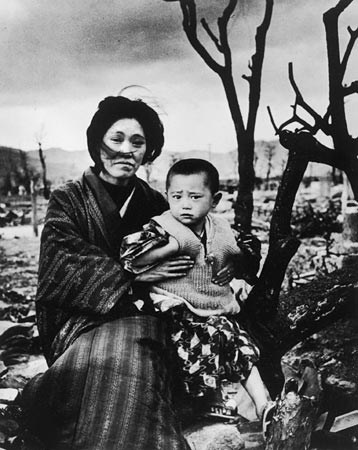It was sixty-five years ago this month when a U.S. bomber dropped its top-secret payload on Hiroshima. This week, for the first time, the U.S. marked the anniversary of the world's first atomic bomb attack by taking part officially in the memorial to the 140,000 victims. It was an important step forward for the politics of memory.

================================
Photograph by Alfred Eisenstaedt
Source : National geographic
Acknoweldgement and respect, if not contrition, can go a long way in readjusting our historical lenses, as I have written in the past. It might also slowly chip away at the role of revenge in directly or indirectly framing our interpretations of history.
Today Hiroshima is completely rebuilt, a modern metropolis of skyscrapers and art museums. All that remains from the dark days of 1945 is the skeleton of the old Industrial Promotion Hall. Now known as the Atom-Bomb Dome, it stands lifeless and naked on the edge of the Montayasu River, directly across from Hiroshima's Peace Memorial Park. Hiroshima's Peace Museum, like the Jewish Holocaust Museum or the Vietnam Memorial Wall, was built not only to stir memories but to inspire lessons.
Depending on one's interpretation of history, Hiroshima is either a metaphor for mass murder or the straw that broke the back of the Japanese military and ended the war in Asia and the Pacific. Today there are still quite a few Americans who do not view the Japanese citizens who perished in Hiroshima and Nagasaki as victims. American survivors of that era and some of their children still regard Hiroshima as payback for Pearl Harbor. But this kind of thinking invariably fogs up the lenses of history because it could never be that simple and real justice is never so formulaic.
Since 1968, successive mayors of Hiroshima have campaigned worldwide for peace and against the proliferation of nuclear weapons. Their critics, including some US war historians, belittle "peace education" as little more than an attempt by Japan to play the victim of war and evade responsibility for crimes against humanity. The Japanese have provided critics with ample reasons for this accusation; historical revisionism tops the list.
• To this day, Japan's Ministry of Education continues to publish sanitized versions of the country's role in World War II.
• In 1997, at the request of bomb survivors, the mayor of Nagasaki at that time deleted words of atonement for atrocities committed by the Japanese military from the final draft of a peace declaration on the 52nd anniversary of that city's destruction.
• For years the Japanese government has criticized books detailing "The Rape of Nanking" in which Japanese military men systematically raped, tortured and murdered tens of thousands of Chinese civilians. Japanese officials have not denied that such crimes took place, but take exception to the numbers of victims cited.
It may be that nations and people who have experienced immense suffering are too consumed by their own pain to empathize with the suffering they inflicted on others. It may be naive to believe that the thousands of Japanese schoolchildren who visit the Peace Memorial each year could ever know as much about Pearl Harbor or Japan's human experiments in Manchuria or the mass rape of women throughout Asia --so-called "comfort women"-- as they do about Hiroshima.
The same can be said about history as it is taught in the United States, which focuses understandably but disproportionately on the loss of life at Pearl Harbor as a direct or implicit justification for the nuclear bombing of Hiroshima. Just think back to 1995, when World War II veterans and their congressional supporters protested a planned exhibit of the Enola Gay (the plane that delivered the A-bomb) at the National Air and Science Museum in Washington. They argued that the exhibit overemphasized the Japanese death toll and did not show the bombing in the proper patriotic perspective. The exhibit was revised, and the museum's curator was forced to resign.
Popular U.S. history tells us that Tokyo refused to quit the war when given the chance. But the US never gave explicit warning to Japan that the A-bomb would be used against it. President Truman - who described the Japanese as "savages, ruthless, merciless, and fanatic" - said his decision to use the bomb on a target surrounded by workers' homes, and without prior warning, would save 1 million American lives. But to this day, there is no evidence that that calculation had any basis in military intelligence.
Some Americans would never subscribe to this argument or historical perspective, for it places on our shoulders far more responsibility than we would like for the deaths of
thousands, and challenges our morality.
A nation's institutional memory is invariably simplistic and achromatic, with good guys in white hats and bad guys in black. But perhaps the real meaning of both Pearl Harbor and Hiroshima is that understanding tragedies of these magnitudes requires casting off our own comfortable interpretations of history, and taking a fresh look based on "new" information that's tempered by the passage of time, and starting anew.